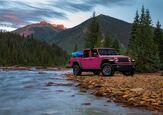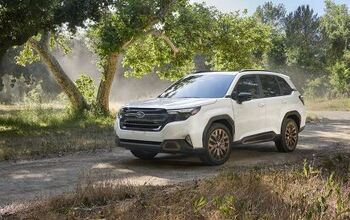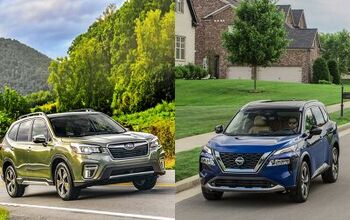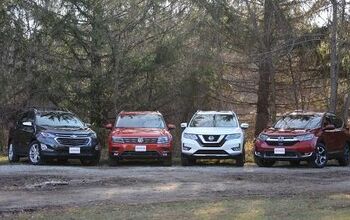Subaru Forester vs Nissan Rogue Comparison: Normcore Crossovers

It’s time for a rematch.
A few years ago, we brought together just about every one of the most popular compact(ish) crossovers for one mega comparison. There, the fresher Nissan Rogue captured third place, while Subaru’s aging Forester still earned a respectable mid-pack finish.
Here at the onset of 2025, the Forester is new once more—and for a change, actually looks like it—while Nissan just refreshed the Rogue last year. As two of the worthy alternatives to the best-sellers of the segment, both Mike Schlee and I needed to find out which one is now the best.
Subaru Forester vs Nissan Rogue Comparison Quick Take
The Nissan Rogue is the fancier choice here, but you’ll be paying a pretty penny for that pleasure. Underneath the blocky new shape, the Forester is familiar: not quick or exciting, but oh-so practical.
What's New for 2025?
Subaru Forester: In that Subaru way, the Forester is all new without necessarily feeling as such. There’s a new look but the platform is the same, though there have been mild strength improvements and fractional dimensional increases. This is a one-engine lineup once more—at least, for a few more months before the hybrid touches down. It’s the familiar 2.5-liter Boxer-four, with two ponies less (180 horsepower) but two pound-feet more (178 lb-ft) than before. Of course, Subaru’s symmetrical all-wheel drive system remains standard across the board.
Nissan Rogue: Nissan updated the Rogue last year, with the subtlest of facelifts and a lift to tech and standard kit across all trims. The latter includes more Google integration, as well as Alexa. Like the Forester, there is just one engine on offer here: a 1.5-liter turbocharged three-cylinder. With 201 hp and 225 lb-ft the Rogue has the advantage here. There’s a small fuel economy advantage too, and even more so if you stick to the standard front-drive setup. Of course, all-wheel drive is optional across the board—in America, anyway. Nissan only offers the Rogue with AWD in Canada for 2025.
Exterior Style:
Forester: After a few generations of indistinguishable Foresters, Subaru has certainly made the new one stand out. Okay, some folks see a whole lot of Ford up front, but you can’t accuse Subaru of recycling anymore. The old C-shaped headlights are gone, with the trendy thin-LED daytime running light (DRL) upper, lower main beam setup we’re seeing in many models these days—Rogue included.
The profile shape is much more familiar, as the Forester’s tall greenhouse has been its calling card basically since introduction.
Around back, there’s a dramatic switch to the taillights, which pinch into a trim piece spread across the entire tailgate. I can’t shake the 2015 Mitsubishi Outlander from my head, but again, nobody will confuse this with a previous Forester. That exhaust cut-out sure looks awkward, too.
2025 Subaru Forester Limited: All the Details
Rogue: The Rogue’s facelift basically comes down to a new grille, new lower bumper designs, and new wheels. I detailed it pretty recently in my 2024 Rogue Platinum review. Essentially, Nissan has softened up that hard-V of the previous grille with one that also aligns better with the Ariya and Kicks. Mike isn’t convinced it’s an improvement, but I think it’s a bit classier, a bit more subtle. Nissan has dialed back the off-road cues too, likely for two reasons: firstly, people just don’t off-road these things, and if they have the desire, the newly launched Rogue Rock Creek will be the choice there.
The profile is a little sleeker, with the Rogue’s taller beltline meaning less glass surface. Those wheels are pretty, but I’d feel bad for whoever has to clean them regularly.
Around back it’s traditional Rogue, with the familiar arrow-shaped taillights and a fillet of chrome along the lower bumper. Don’t worry, there’s a big Platinum badge to tell people you bought the fanciest one.
2025 Nissan Rogue Platinum: All the Details
Powertrain and Fuel Economy:
Forester: Mike and I agree on this after no time: the Forester’s weak point in this comparison is its engine. “the one area Subaru still struggles is in the engine department,” notes Schlee. “More refined and much quieter, the 2.5-liter still lacks the low-end torque so many of its competitors, such as the Rogue, do.” It’s fine enough around town, as Subaru’s CVT is one of the better ones out there, so it masks the comparative dearth of torque. As Mike pointed out, it’s much quieter now too, including on the highway—where you’ll definitely be wringing it out for passes.
Subaru’s AWD system has been touted as a strength for years, but in an impromptu “drag race” across a snow- and ice-covered parking lot, these two were neck and neck.
One odd thing about the Forester: it requires much more pedal pressure to activate its start-stop system at a light. Swapping between the two vehicles, I’d regularly forget that, although that’s something of a mixed blessing, because the Forester restarts with a big grumble and noticeable shake.
That power disadvantage doesn’t translate into better figures at the pumps, either. The EPA quotes 26 mpg city and 33 mpg highway for this Forester Limited, for a combined 29 mpg figure. Canadian equivalents are 9.1, 7.2, and 8.2 L/100 km, respectively.
Rogue: The Rogue’s turbo engine has a nearly 50 lb-ft advantage over the larger Subaru engine. This translates to much smoother and quicker progress around town. The CVT is just as responsive here, but since it doesn’t need to rev out for peak torque, it keeps the noise nice and low. At least, it’s quiet in the city. On the highway, the Rogue gets very noisy, as it makes use of the entire rev range. It’s here where the turbo starts to run out of steam, but nonetheless feels quicker than the pokey Subaru.
The AWD setup here is quick to send power to the rear when needed. We didn’t experience any deep snow to really push the powertrain to the limits, but in typical usage, these two put their power down equally cleanly.
The Nissan has the fuel economy advantage, however, scoring 28 mpg city, 34 mpg highway, and 31 mpg combined. (Canadian figures: 8.4, 6.7, 7.6 L/100 km.)
We can’t ignore that the NHTSA is currently investigating Nissan’s variable compression engines, including the 1.5-liter found here. While failures have been exceedingly rare so far, it’s worth noting if you’re considering a Rogue.
Handling and Drivability:
Forester: We could almost sum up this entire section with Mike’s one quote. “Neither of these vehicles are meant for enthusiastic driving and neither excel in that regard. That stated, they are quick to respond to inputs and wholly predictable to drive.”
But there are subtle differences. The Forester has that classic Subaru feel: it’s loose and limber in the way that makes it instantly familiar and comfortable. It excels on poor surfaces, where the handling stays helpfully predictable. Body lean is kept in check as well.
Rogue: Like the Forester, the Rogue has light, accurate steering and a brake pedal that feels foolproof. There’s an aloofness here that isn’t present in the Forester. The Rogue feels like a bigger vehicle, and that size keeps you just a bit further away from the action happening up front. Maybe that’s a good thing: maybe you want that isolation, and it feels a little more premium and luxurious as a result.
Ride Quality and Comfort:
Forester: The Forester Limited rides on 18-inch wheels, affording it more sidewall for a smoother overall ride. Paired with the long-travel suspension, it soaks up bumps with a fluidity the Nissan can’t quite match.
In terms of front seat comfort, Mike finds these two SUVs roughly equal, while I just prefer the Nissan. It’s not that the Subaru’s seating is bad—it isn’t, and the positioning is great for visibility—but the Nissan has more lower back support. Maybe I’m just getting old…
Rogue: The Rogue’s ride is comparably stiff: not in the sporty sense either, just about 15-percent harsher. It’s not enough to ruin its daily-driver equilibrium, but is noticeable when diving between the two vehicles for filming.
Rear seat comfort is almost a wash. I find the Subaru’s lower cushion placement a bit better with it being taller and longer. The Nissan has the big pano roof, but the Subaru’s low waistline lets in almost as much natural light anyway.
Interior Style and Quality:
Forester: Subaru is pulling no surprises here: the Forester cabin looks like every other one from the brand the last five years. Now that does make for a noticeable material improvement over the old one, and again, we need to stress how much better noise isolation is in the ’25 Forester. The shield-like space for the touchscreen and central air vents, along with the fade-away hexagonal pattern ahead of the passenger, is about as close to style as Subaru will get. This cabin is about functionality first, and the Forester succeeds there, with large door pockets for plenty of storage.
“the Forester’s interior still feels more utilitarian compared to the Rogue’s,” notes Schlee, adding that “it also feels more functional however and may better live up to the abuse of daily life.” I’m inclined to agree.
Speaking of, the Forester’s cargo capacity is a useful 35.7 cubic feet (1,011 liters) with the rear seats up, nearly doubling to 69.9 cu ft (1,979 L) when operating in two-seater mode.
Rogue: Nissan gave the Rogue a serious glow-up at the beginning of this generation, and it was so nice that the mid-cycle facelift didn’t change a thing. This is the classier, more upscale cabin—and not just because of that sliver of wood trim. The design is pared back without being sparse, and Nissan has mercifully kept a majority of primary controls as actual physical items, not just shoved them into a touchscreen. We appreciate the lack of piano black down in the center console, though the flat black plastic rectangle surrounding the shifter isn’t exactly an improvement. The quilting of the seats is another premium touch.
The Rogue might not look like it, but sheer numbers give it the cargo capacity edge. The seats-down measure is 36.8 cu ft (1,042 L), while seats-up hits an even (2,039 L).
Tech and Safety:
Forester: Subaru’s 11.6-inch central touchscreen is very familiar now. It sure ain’t pretty, nor is it quick, and it’ll wash out in sunlight. But it’s easy enough to use, and now includes wireless Apple CarPlay and Android Auto. Mike prefers the setup. There’s also a tiny screen between the analog instruments, which can scroll through a few different presets.
While the Scooby misses out on niceties such as tri-zone climate control and a power-retractable roof shade, in Canada it offers front ventilated seats on the Premier (equivalent to the US Touring).
Rogue: Nissan’s 12.3-inch touchscreen is slicker and quicker than that of the Forester. I’m a fan, though Mike prefers the easy usability of the Subaru system. New for 2024 is Google Built-In, bringing in Google Assistant, Google Maps, and Google Play all natively. An all-digital instrument cluster measures the same size, offering more customization.
Nissan’s hands-free highway drive assist is optional on the Rogue Platinum, though it would drive the as-tested price even further north.
Value Dollars and Sense:
Forester: This is where the Forester claws back major points. As-tested, this Limited trim tester would go for $39,130 ($45,290 CAD), which includes the $1,600 optional package for the native navigation, Harman Kardon sound system, and reverse automatic braking, all of which are baked into the standard Canadian price. Even moving up to a trop-trim model would undercut the Rogue.
Rogue: The as-tested price for this Rogue Platinum would be $42,675 ($48,423 CAD). The only other option to add is the pricey Tech package, which adds Nissan’s ProPilot Assist 2.1 hands-free highway drive assist, rain-sensing wipers, and an enhanced 360-degree camera.
Final Thoughts: Subaru Forester vs Nissan Rogue Comparison
The Forester has improved more than its on-paper changes suggest. Much more refined than before, it is an incredibly practical family vehicle. If we had brought in two mid-level trims, we expect the Subaru might’ve clinched it…
But we didn’t. With the two testers on hand, even though the Nissan is pricier, crucially it feels worth it. While it has a stiffer ride, the cabin is nicer and there’s more tech, some of which you simply can’t have on any Forester. Pair all that with the more powerful and efficient powertrain, and the Nissan Rogue notches another win against the Forester here. Guess we’ll have to have another rematch once the hybrids are around…
Become an AutoGuide insider. Get the latest from the automotive world first by subscribing to our newsletter here.

Kyle began his automotive obsession before he even started school, courtesy of a remote control Porsche and various LEGO sets. He later studied advertising and graphic design at Humber College, which led him to writing about cars (both real and digital). He is now a proud member of the Automobile Journalists Association of Canada (AJAC), where he was the Journalist of the Year runner-up for 2021.
More by Kyle Patrick















































Comments
Join the conversation